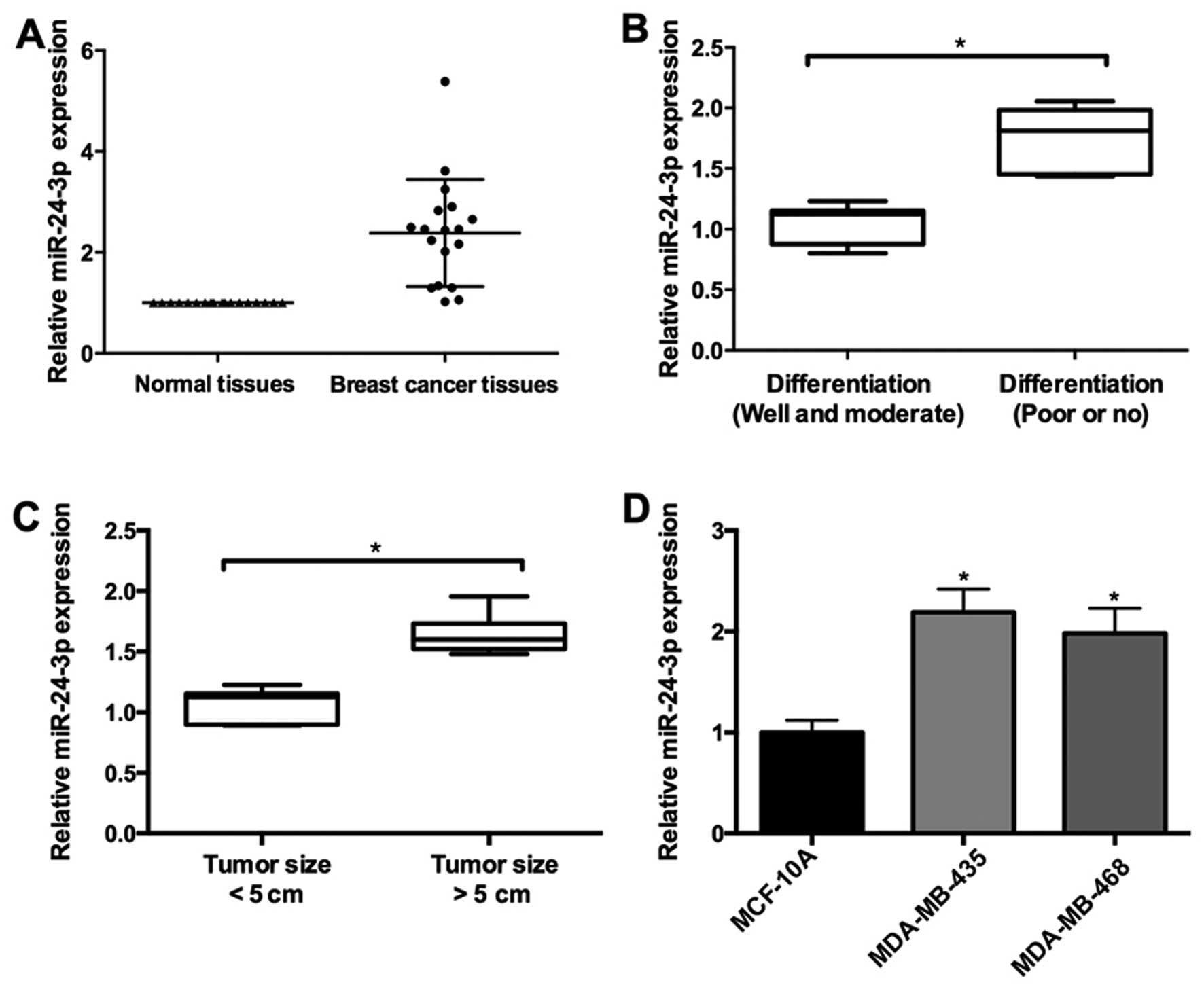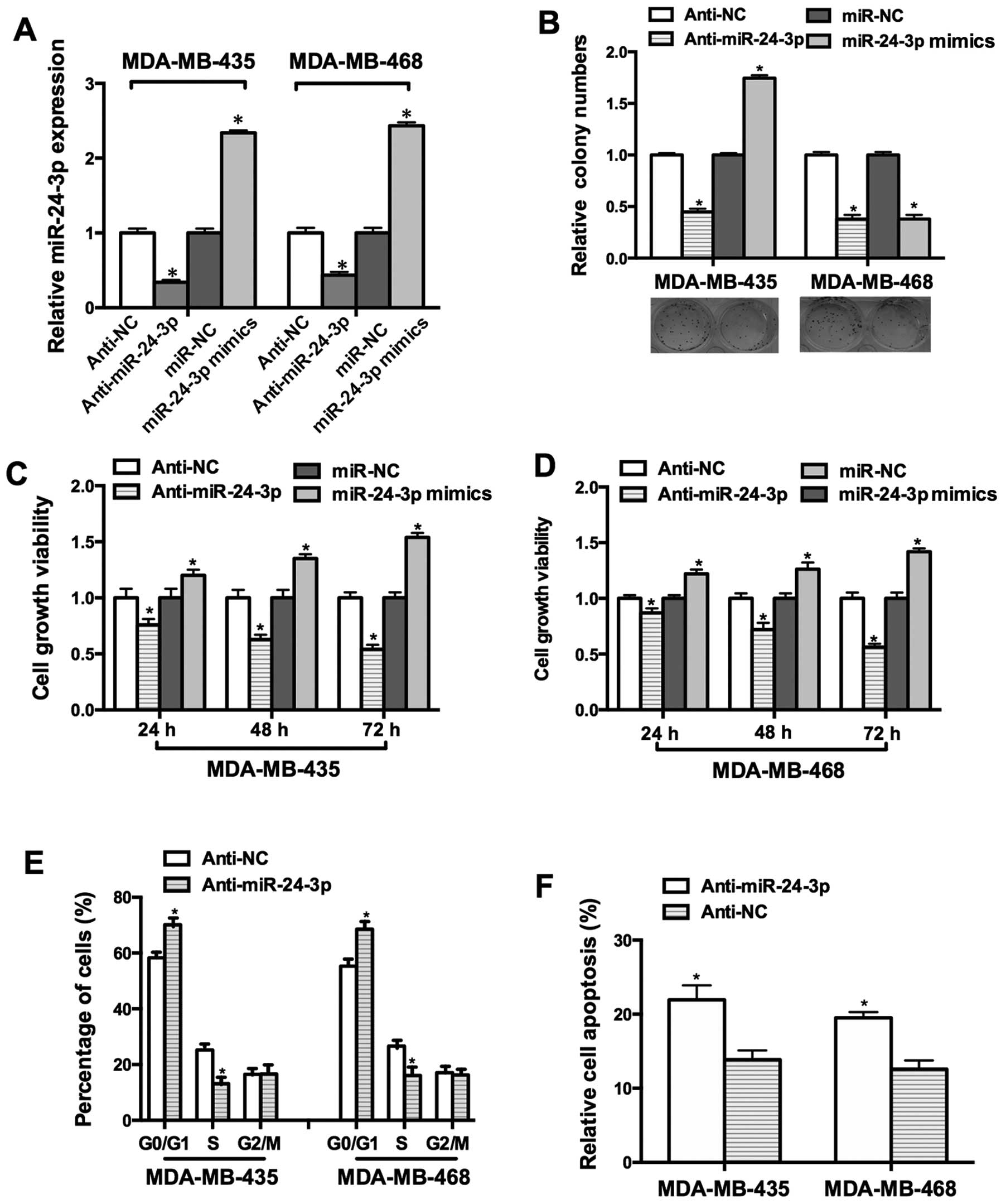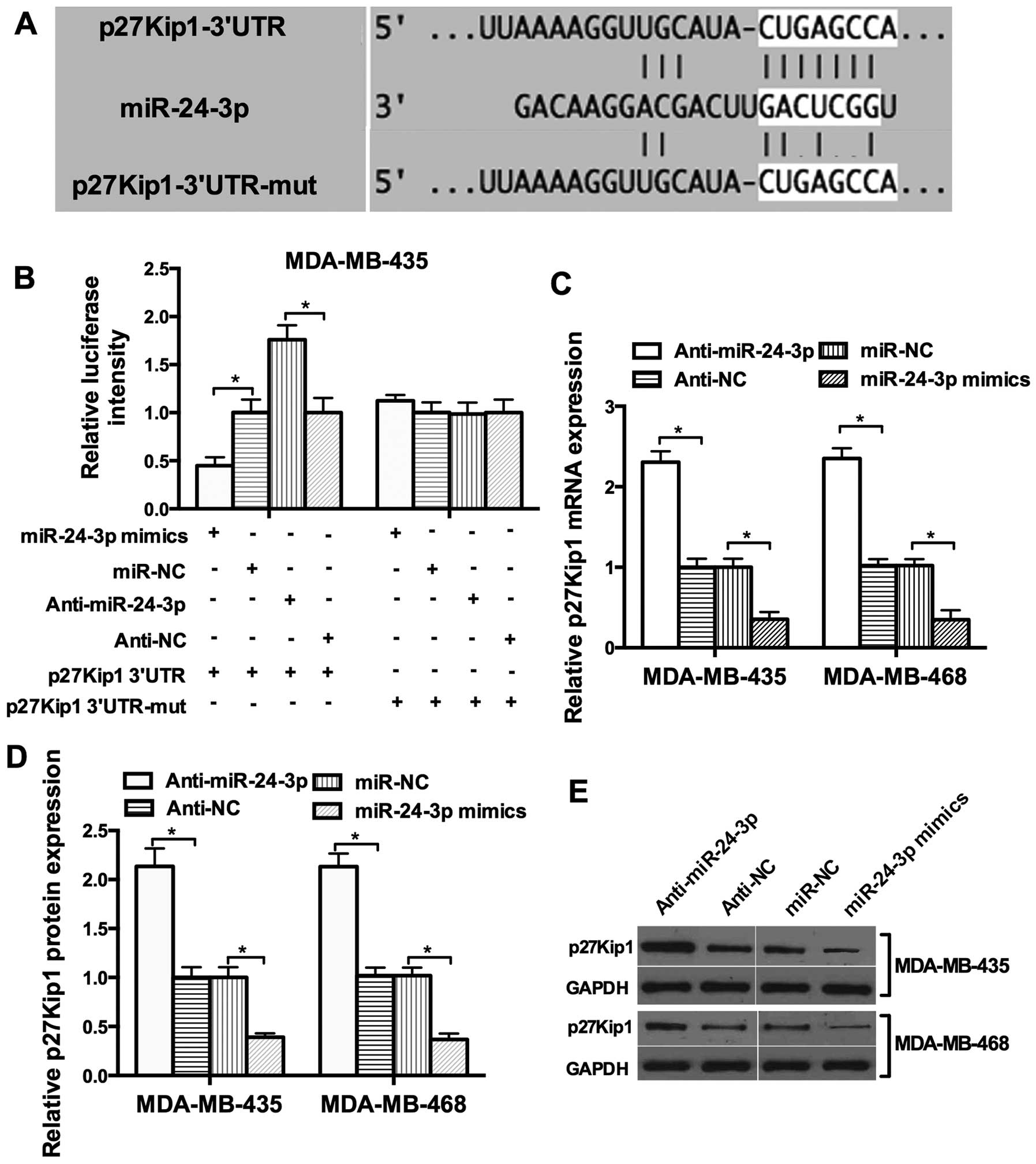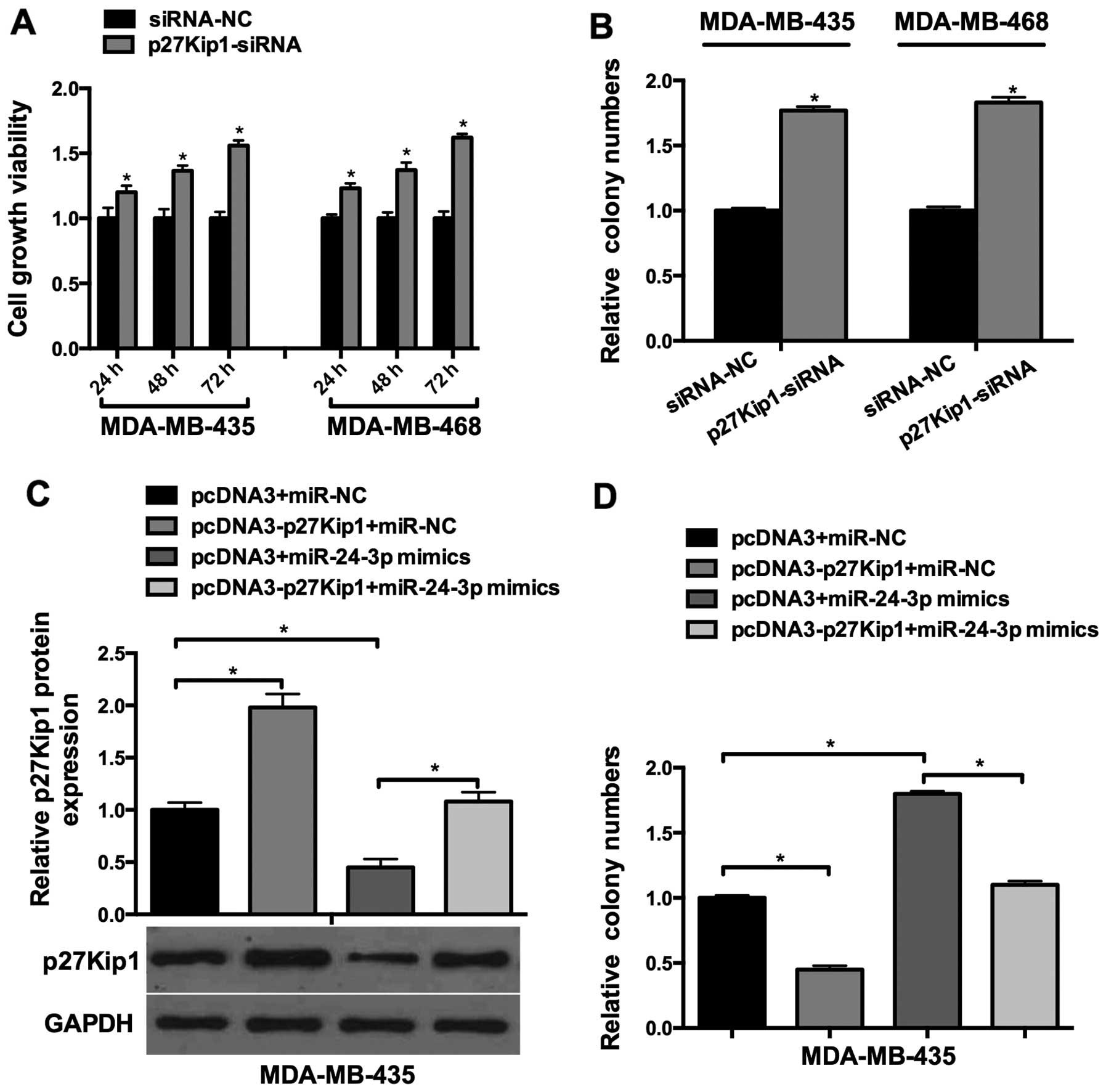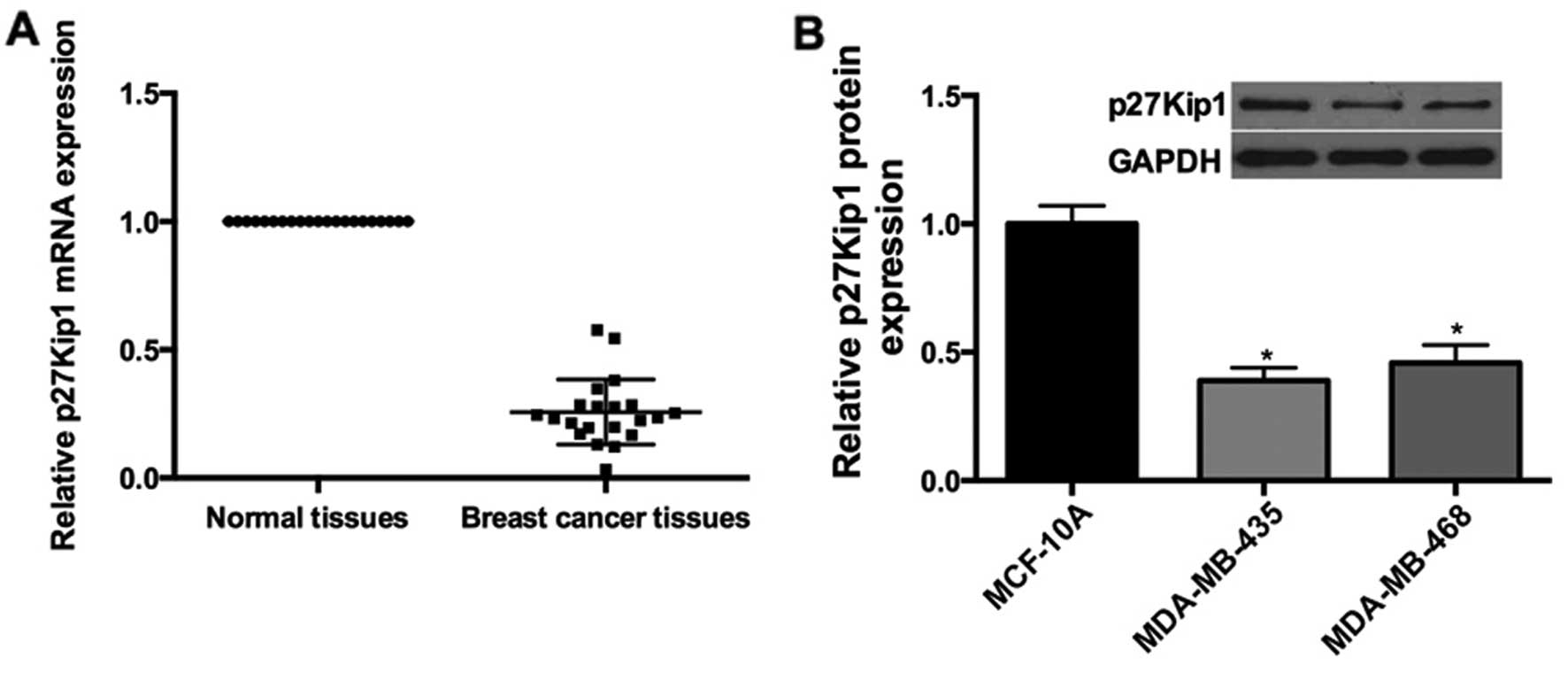miRNA-24-3p promotes cell proliferation and inhibits apoptosis in human breast cancer by targeting p27Kip1
- Authors:
- Published online on: June 4, 2015 https://doi.org/10.3892/or.2015.4025
- Pages: 995-1002
Abstract
Introduction
microRNAs (miRNAs) are endogenous 19-25 nucleotide short RNAs and play critical roles in cancer progression through either protein translation repression or mRNA degradation to regulate their target mRNAs (1). miRNAs have a strong impact on all the main aspects of tumorigenesis by controlling the major regulators of cell cycle progression, senescence, apoptosis and autophagy, along with tumor cell motility, invasion and metastasis (2-4). The pathogenic, diagnostic and prognostic roles of miRNAs have been extensively studied in breast cancer (5). miRNAs have emerged as important biomarkers for breast cancer risk stratification and outcome prediction (6). In addition, miRNAs represent promising therapeutic tools against breast cancer, as shown by the tumor regression achieved by the in vivo delivery of let-7 or miR-34 family members (7,8).
The cell cycle regulatory protein p27Kip1 is frequently inactivated in many human cancers. This inactivation is caused by enhancing its degradation, repressing its transcription, or by promoting its cytoplasmic sequestration, in different tumor types and in different subsets of patients within tumor types using distinct mechanisms (9,10). miRNA-mediated control is one of the post-transcriptional mechanisms responsible for p27Kip1 downregulation in cancer cells. To date, a set of miRNAs has been verified to target p27Kip1, such as miR-25 (11), miR-200 (12), miR-802 (13), miR-194 (14), miR-181b (15), miR-196a (16) and miR-221 (17).
In the present study, the role of miR-24-3p and p27Kip1 in breast cancer tissues and cells was investigated. Our findings verified that the expression of miR-24-3p was upregulated, while p27Kip1 was downregulated in breast cancer tissues and inversely correlated with the expression of miR-24-3p. Overexpression of miR-24-3p promoted breast cancer cell growth, colony formation, cell cycle and inhibited cell apoptosis. Furthermore, we experimentally validated that miR-24-3p directly targeted the 3′untranslated region (3′UTR) of p27Kip1 and suppressed its expression. Finally, we determined that knockdown of p27Kip1 promoted cell proliferation and overexpression of p27Kip1 abrogated the miR-24-3p promoted cell proliferation in breast cancer cells. Therefore, our results demonstrated that miR-24-3p can mediate its tumor oncogenic function, at least in part, by suppressing the expression of p27Kip1. Altogether, our study characterized a novel microRNA-mediated mechanism of p27Kip1 regulation and may provide a novel therapeutic target for breast cancer.
Materials and methods
Patient samples
Breast cancer specimens and adjacent normal tissues were collected at the Third Affiliated Hospital of Harbin Medical University (Harbin, China) from January 2011 to December 2013. All the patients recruited into the present study did not receive radiotherapy, chemotherapy or any other treatment before and after operation. Surgical specimens of the resected tumor were collected, and lumps of tumors as well as adjacent normal tissues, which were at least 2 cm distal to the tumor margins, were snap-frozen in liquid nitrogen for miR-24-3p and p27Kip1 assays. Written informed consent was obtained from all the study participants. The use of tissue samples was approved by the Ethics Committees of the Third Affiliated Hospital of Harbin Medical university.
Cell culture and transfection
Three widely used cell lines, MCF-10A, MDA-MB-435 and MDA-MB-468 were used in the present study, and were obtained from the American Type Culture Collection (ATCC) and maintained in RPMI-1640 medium with 10% fetal bovine serum (FBS) and 1% antibiotics (both from Invitrogen, Grand Island, NY, USA). Transfection of the cells with miR-24-3p mimics, miR-control, anti-miR-24-3p or anti-NC (GenePharma, Shanghai, China) was performed using Lipofectamine™ 2000 (Invitrogen) according to the manufacturer’s instructions.
Detection of cell phenotypes
The effect of miR-24-3p on the proliferation of breast cancer cells was evaluated by the MTT assay. MDA-MB-435 and MDA-MB-468 cells were plated in 96-well culture plates (3×103/well). After a 24-h incubation, the cells were transfected with miR-24-3p mimics (30 pmol) or miR-control (30 pmol) for 12, 24 and 48 h. Then MTT (0.5 mg/ml; Sigma-Aldrich, St. Louis, MO, USA) was added to each well (20 μl/well). After 4 h of additional incubation, the MTT solution was discarded and 200 ml of DMSO (Sigma-Aldrich) was added, and the plates were shaken gently. The absorbance was measured on a microplate reader (VersaMax; Molecular Devices, Sunnyvale, CA, USA) at a wavelength of 570 nm. For the colony formation assay, cells were counted and seeded in 12-well plates (in triplicate) at 100 cells/well. Fresh-cultured medium was replaced every 3 days. The number of viable cell colonies was determined after 14 days and the colonies were fixed with methanol, stained with crystal violet, photographed and counted under a microscope (IX71; Olympus, Tokyo, Japan). Each experiment was performed in triplicate.
Cell cycle and apoptosis assays
Transfected MDA-MB-435 and MDA-MB-468 cells were seeded into 6-well plates for 24 h in complete medium. Then, the cells were deprived of serum for 48 h followed by returning the complete medium for an additional 24 h. After that, the cells were collected by centrifugation, fixed in 95% ethanol, incubated at −20°C overnight and washed with phosphate-buffered saline (PBS). The cells were then resuspended in 1 ml of FACS solution [PBS, 0.1% Triton X-100, 60 μg/ml propidium iodide (PI), 0.1 mg/ml DNase-free RNase and 0.1% trisodium citrate] with a final incubation on ice for 30 min. The cells were analyzed using a FACSCalibur flow cytometer (Beckman Coulter, Fullerton, CA, USA). A total of 10,000 events were counted for each sample. For the Annexin V assay, the MDA-MB-435 and MDA-MB-468 cells were transfected. After 48 h, the DNA content was determined by PI staining as described by Yi et al (18), and Annexin V staining was performed with the Vybrant Apoptosis Assay kit (Invitrogen, Carlsbad, CA, USA).
Western blotting
Cells were plated at a concentration of 106 cells/ml. After transfection with the miR-24-3p mimics or anti-miR-24-3p for 48 h, the cells were lysed with RIPA buffer (1X pbS, 1% Np-40, 0.1% SDS, 5 mM EDTA, 0.5% sodium deoxycholate, 1 mM sodium orthovanadate and 1% PMSF). After centrifuging at 12,000 rpm for 15 min at 4°C to remove the cell debris, the supernatant was transferred and the protein concentration were determined using Bradford protein dye reagent (Bio-Rad, Hercules, CA, USA). The samples were resolved by 10% SDS-PAGE and transferred to a nitrocellulose membrane. After blocking with 5% skimmed milk at room temperature for 1 h, the membrane was incubated with the p27Kip1 or GAPDH antibody (sc-528 and sc-25778, dilution 1:1,000; Santa Cruz biotechnology, Santa Cruz, CA, USA) at 4°C overnight. After washing, HRP-conjugated rabbit secondary monoclonal antibody (#7074, dilution 1:1,000; Cell Signaling Technology, Beverly, MA, USA) was added and incubated at room temperature for 1 h. Densitometric analysis of the band intensity was performed using the software NIH ImageJ (version 1.32j).
Quantitative RT-PCR for miR-24-3p
The small RNA fraction was isolated from the cells using the mirVana miRNA isolation kit (Ambion, Austin, TX, USA) according to the manufacturer’s instructions. Quantitative RT-PCR was performed using the mirVana qRT-pCR miRNA Detection kit and the miR-24-3p and U6 snRNA primer sets (Ambion) in a Roche LightCycler (Roche, basel, Switzerland). The LightCycler software package version 5.3.2 was used to determine the expression of miR-24-3p relative to that of U6 snRNA. Relative changes in miR-24-3p levels were calculated using a standard curve constructed from serial dilutions of control RNA.
Construction of 3′UTR reporter plasmid and luciferase assay
The full length 3′UTR of p27Kip1 was cloned by standard procedures into the pMIR-Report vector (Ambion), immediately downstream of the stop codon of the luciferase gene to generate the pMIR-p27Kip1-3′UTR luciferase reporter plasmid. Mutagenesis of the pMIR-p27Kip1-3′UTR was performed using a QuikChange Site-Directed Mutagenesis kit (Stratagene, La Jolla, CA, USA). The two binding sites of miR-24-3p on the p27Kip1 3′UTR were mutated simultaneously to generate pMIR-p27Kip1-3′UTR-mut and to analyze their functional role. Cells were co-transfected with 2 mg wild-type pMIR-p27Kip1-3′UTR or pMIR-p27Kip1-3′UTR-mut, 50 pmol miRNA mimics and 0.01 mg Renilla in 24-well plates. Forty-eight hours after transfection, the cells were washed and lysed with passive lysis buffer (Promega, Madison, WI, USA), and the luciferase activity was measured using a luminometer (Sirius; Titertek-berthold, pforzheim, germany).
Knockdown of p27Kip1 by siRNA and contruction of the p27 overexpression plasmid
The transient transfection of p27Kip1-siRNA or pCDNA-p27Kip1 was performed using Lipofectamine 2000 according to the manufacturer’s instructions. After 48-72 h, the cells were analyzed to determine the transfection efficiency by western blot analysis. The siRNA targeting p27Kip1 was purchased from Santa Cruz biotechnology (sc-29429). The full-length human p27Kipl cDNA (1.5 kb) was subcloned into the EcoRI and BamHI sites of the eukaryotic expression vector pCDNA3 in the sense orientation resulting in the pCDNA-p27 plasmid.
Statistical analysis
A Student’s t-test was performed to analyze the significance of differences between the sample means obtained from three independent experiments. Differences were considered statistically significant at p<0.05.
Results
Relative expression of miR-24-3p in the breast cancer tissues and cells
In the present study, the expression level of miR-24-3p was measured with qRT-pCR in 26 pairs of breast cancer and adjacent normal tissues. miR-24-3p was upregulated in the breast cancer tissues (Fig. 1A). In addition, miR-24-3p expression was associated with pathological differentiation and tumor size in the breast cancer tissues. As shown in Fig. 1b, the expression of miR-24-3p was upregulated in breast cancer tissues with well and moderate differentiation compared with tissues with poor or no differentiation. Furthermore, higher expression of miR-24-3p was observed in breast cancer tissues with tumor size >5 cm compared to the tissues with tumor size <5 cm (Fig. 1C).
To further confirm the role of miR-24-3p during breast cancer progression, we determined the expression of miR-24-3p in two breast cancer cell lines (MDA-MB-468 and MDA-MB-435) and non-malignant breast epithelial MCF-10A cells. Compared to the MCF-10A cells, the expression of miR-24-3p was higher in the MDA-MB-468 and MDA-MB-435 cells (Fig. 1D).
miR-24-3p promotes breast cancer proliferation and inhibits apoptosis
To investigate the function of miR-24-3p in breast cancer cell lines, MDA-MB-435 and MDA-MB-468 were transfected with miR-24-3p mimics. As shown in Fig. 2A, the miR-24-3p mimics increased the expression of miR-24-3p by 2.3-fold and 2.4-fold in the MDA-MB-435 and MDA-MB-468 cells, while anti-miR-24-3p reduced the expression of miR-24-3p by 0.3-fold and 0.4-fold, respectively. MTT and colony formation assays were performed to detect the effects of miR-24-3p on cell growth. Our data demonstrated that the miR-24-3p mimics facilitated cell growth and anti-miR-24-3p inhibited cell growth (Fig. 2B–D).
To address the mechanism underlying miR-24-3p-modulated cell growth, FACS assay was used to detect the effect of miR-24-3p on the cell cycle. The proportion of cells in the G0/G1 phase was increased in the MDA-MB-435 and MDA-MB-468 cells transfected with anti-miR-24-3p and the proportion of cells in the S phase was decreased (Fig. 2E). Moreover, the Annexin V apoptosis assay showed that anti-miR-24-3p promoted the apoptosis of the MDA-MB-435 and MDA-MB-468 cells (Fig. 2F).
miR-24-3p directly targets and inhibits p27Kip1 protein expression
To explore the potential target of miR-24-3p, bioinformatic analysis with TargetScan and miRanda was used and a set of different target genes were predicted. Among these candidate targets, p27Kip1 attracted our attention immediately since it was predicted by the two algorithms (Fig. 3A). To investigate whether miR-24-3p directly targets p27Kip1 in breast cancer cells, the 3′UTR luciferase reporter assay was performed. miR-24-3p had an obvious inhibitory effect on the luciferase intensity of the wild-type 3′UTR luciferase reporter. However, the inhibitory effect of miR-24-3p was reduced in the presence of the mutant 3′UTR luciferase reporter (Fig. 3B). We then tested whether miR-24-3p affects the expression of endogenous p27Kip1. The restoration of miR-24-3p expression resulted in a reduction in endogenous p27Kip1 mRNA and protein expression in the MDA-MB-435 and MDA-MB-468 cells (Fig. 3C–E). These results provide evidence that miR-24-3p directly targets the 3′UTR of p27Kip1 and suppresses its expression.
miR-24-3p-promoted cell proliferation is mediated by p27
To investigate the function of p27Kip1 in breast cancer cell lines, p27Kip1-siRNA was transfected into the MDA-Mb-435 and MDA-Mb-468 cells. As shown in Fig. 4A, p27Kip1-siRNA increased the cell viability of the MDA-MB-435 and MDA-MB-468 cells in a time-dependent manner. Colony formation assays showed that relative cell growth was significantly promoted in the p27Kip1-siRNA-transfected cells (Fig. 4B). Next, we explored whether miR-24-3p-induced breast cancer cell growth was mediated by p27Kip1. miR-24-3p mimics and pcDNA3-p27Kip1 were co-transfected into the breast cancer cells, which showed that miR-24-3p-induced p27Kip1 downregulation was rescued by the overexpression of p27Kip1 (Fig. 4C); Furthermore, colony formation assay showed that miR-24-3p-induced cell proliferation was aborted by the overexpression of p27Kip1 (Fig. 4C). These results suggested that miR-24-3p-induced breast cancer cell growth was mediated by p27Kip1.
p27 expression is downregulated in breast cancer tissues and cells
Since we demonstrated the expression levels of miR-24-3p in breast cancer cell lines and tissues, qRT-pCR was performed. The results showed that p27Kip1 mRNA was downregulated in the breast cancer tissues compared with the adjacent normal tissues (Fig. 5A); Furthermore, the expression of p27Kip1 was obviously decreased in the MDA-Mb-435 (0.4-fold) and MDA-MB-468 (0.46-fold) cells compared to the level in the MCF-10A cells (Fig. 5B).
Discussion
Breast cancer is the most common cancer in women around the world. Breast cancer is influenced by a number of environmental factors and is characterized by molecular heterogeneity. Despite the various existing screening programs and new therapeutic strategies implemented to treat breast cancer which have significantly reduced mortality rates, the molecular mechanisms underlying breast cancer pathogenesis are only partially understood.
Numerous studies have suggested the potential role of microRNAs as oncogenes or tumor-suppressor genes affecting the cell cycle and apoptosis via the regulation of different target genes in cancer (19). A set of miRNAs with differential expression levels and critical tumor suppressive roles has been described in breast cancer cells, including miR-145, miR-122a, miR-125a-5p, miR-126, miR-200c, miR-10b and miR-96 (20). Furthermore, multivariate analysis in breast cancer identified that downregulation of miR-155 and let-7 expression was significantly correlated with a shorter patient survival rate (21,22). miR-24-3p is mainly produced from two miRNA clusters, miR-23a-27a-24-2 and miR-23b-27b-24-1, which is a master regulator in a variety of tumors (23,24). It is reported that miR-24-3p may function differently regarding cell proliferation in different cell types (24). For example, miR-24-3p can repress HeLa cell proliferation, while it facilitates cell proliferation of TGF-β-treated hepatocellular carcinoma cells (huh7), as well as lung carcinoma cells (A549) and glioblastoma cell lines (25–27). Therefore, miRNA expression patterns vary under different biological conditions (23).
Here, we determined that the miR-24-3p expression level in breast cancer and normal tissues displayed marked upregulation by real-time PCR analysis. Furthermore, upregulation of miR-24-3p was also observed in poorly or undifferentiated tissues, and tissues with tumor size >5 cm. Thus, these results suggest the potential tumor oncogenic role of miR-24-3p. This was further confirmed in the breast cancer cell lines. Using breast cancer cell lines, MDA-MB-435 and MDA-MB-468, we confirmed that overexpression of miR-24-3p increased cell proliferation as determined by MTT and colony formation assays. Recently, an increasing number of studies have demonstrated that the dysregulation of miRNAs affects cell cycle progression and apoptosis in many types of human cancers. Researchers have identified that miR-15a can inhibit the cell cycle by targeting CCNE1 in breast cancer cells (28). Functional assays revealed that MCF-7 cell growth can be suppressed by miR-497 through increasing the percentage of early apoptotic cells (29). In the present study, we identified that overexpression of miR-24-3p significantly suppressed the apoptosis of MDA-MB-435 and MDA-MB-468 cells. Furthermore, we confirmed that miR-24-3p can promote cell cycle transition.
miRNAs exert their function through partially binding the 3′UTR of mRNAs (30). Here, we defined a specific function for miR-24-3p in breast cancer, showing that they repress expression of p27Kip1. Analysis of the 3′UTR of p27Kip1 suggested that repression of p27Kip1 is a consequence of the direct binding of miR-24-3p to sites in the 3′UTR. Based on the luciferase reporter data, miR-24-3p was able to cause at least a 2-fold reduction in the levels of p27Kip1 protein via direct binding to the 3′UTR of its mRNA. Recent studies have shown that p27Kip1 is overexpressed in several tumors compared with normal tissues (31). Furthermore, research demonstrated that p27Kip1 can exhibit anti-apoptotic effects or sustain cell growth in several cancer types (32). In the present study, our findings demonstrated that p27Kip1 was expressed at higher levels in breast cancer tissues compared with that in the normal tissues. To further confirm that miR-24-3p can directly target p27Kip1, a knockdown plasmid of p27Kip1 (p27Kip1-siRNA) was used. p27Kip1-siRNA promoted MDA-Mb-435 and MDA-MB-468 cell proliferation. Furthermore, the transfection of the p27Kip1 overexpression plasmid (pcDNA3-p27Kip1) rescued miR-24-3p-induced p27Kip1 downregulation and abrograted the miR-24-3p-promoted cell proliferation.
These data that connect miR-24-3p to p27Kip1 suggested that miR-24-3p-promoted breast cancer cell proliferation was, at least in part, mediated by p27Kip1. Gonzalez et al previously showed that inhibition of cdk4 activity enhanced the translation of p27Kip1, providing a link between these two cell cycle regulators. This effect was shown to be mediated by the 3′UTR of p27Kip1 (33). In the present study, we demonstrated that miR-24-3p can suppress the expression of p27Kip1 through interaction with its 3′UTR, therefore, miR-24-3p may have a crosstalk with the cdk4/p27Kip1 regulatory axis.
Finally, the data here suggest that miR-24-3p may be a potential therapeutic target for the treatment of breast cancer. To date, miR-24-3p inhibition may be a potential way to reduce the aggressive growth of breast cancer by restoring normal levels of p27Kip1. This could potentially decrease breast cancer cell proliferation. The effectiveness of this would in part depend on what additional targets are regulated by miR-24-3p in both cancer and normal tissues.
In conclusion, the present study provides new insights into the specific function of miR-24-3p and its mechanism in breast cancer proliferation, and suggests that targeting of miR-24-3p may provide a potential therapeutic strategy for blocking proliferation in breast cancer.
Acknowledgments
The present study was supported by the Key Fund project of education (no. 12511z019), the Fund for excellent Academic Leaders in harbin (no. 2011RFXYS060) and the Chunhui Fund of the Ministry of Education (no. Z2010006).
References
|
Iorio MV, Casalini P, Piovan C, Braccioli L and Tagliabue E: Breast cancer and microRNAs: Therapeutic impact. Breast. 20(Suppl 3): S63–S70. 2011. View Article : Google Scholar : PubMed/NCBI | |
|
Piovan C, Palmieri D, Di Leva G, Braccioli L, Casalini P, Nuovo G, Tortoreto M, Sasso M, Plantamura I, Triulzi T, et al: Oncosuppressive role of p53-induced miR-205 in triple negative breast cancer. Mol Oncol. 6:458–472. 2012. View Article : Google Scholar : PubMed/NCBI | |
|
Wang D, Liu D, Gao J, Liu M, Liu S, Jiang M, Liu Y and Zheng D: TRAIL-induced miR-146a expression suppresses CxCR4-mediated human breast cancer migration. FEBS J. 280:3340–3353. 2013. View Article : Google Scholar : PubMed/NCBI | |
|
Yang S, Li Y, Gao J, Zhang T, Li S, Luo A, Chen H, Ding F, Wang X and Liu Z: MicroRNA-34 suppresses breast cancer invasion and metastasis by directly targeting Fra-1. Oncogene. 32:4294–4303. 2013. View Article : Google Scholar | |
|
Sun EH, Zhou Q, Liu KS, Wei W, Wang CM, Liu XF, Lu C and Ma DY: Screening miRNAs related to different subtypes of breast cancer with miRNAs microarray. Eur Rev Med Pharmacol Sci. 18:2783–2788. 2014.PubMed/NCBI | |
|
Mulrane L, Klinger R, Mcgee SF, Gallagher WM and O’Connor DP: microRNAs: A new class of breast cancer biomarkers. Expert Rev Mol Diagn. 14:347–363. 2014. View Article : Google Scholar : PubMed/NCBI | |
|
Barh D, Malhotra R, Ravi B and Sindhurani P: MicroRNA let-7: An emerging next-generation cancer therapeutic. Curr Oncol. 17:70–80. 2010. View Article : Google Scholar : PubMed/NCBI | |
|
Zhang B, Pan X, Cobb GP and Anderson TA: microRNAs as oncogenes and tumor suppressors. Dev Biol. 302:1–12. 2007. View Article : Google Scholar | |
|
Lane HA, Beuvink I, Motoyama AB, Daly JM, Neve RM and Hynes NE: ErbB2 potentiates breast tumor proliferation through modulation of p27(Kip1)-Cdk2 complex formation: Receptor overexpression does not determine growth dependency. Mol Cell Biol. 20:3210–3223. 2000. View Article : Google Scholar : PubMed/NCBI | |
|
Motti ML, Califano D, Troncone G, De Marco C, Migliaccio I, Palmieri E, Pezzullo L, Palombini L, Fusco A and Viglietto G: Complex regulation of the cyclin-dependent kinase inhibitor p27kip1 in thyroid cancer cells by the pI3K/AKT pathway: Regulation of p27kip1 expression and localization. Am J pathol. 166:737–749. 2005. View Article : Google Scholar : PubMed/NCBI | |
|
Wang XH, Cai P, Wang MH and Wang Z: microRNA-25 promotes osteosarcoma cell proliferation by targeting the cell cycle inhibitor p27. Mol Med Rep. 10:855–859. 2014.PubMed/NCBI | |
|
Tong J, Fu Y, Xu X, Fan S, Sun H, Liang Y, Xu K, Yuan Z and Ge Y: TGF-β1 stimulates human Tenon’s capsule fibroblast proliferation by miR-200b and its targeting of p27/kip1 and RND3. Invest Ophthalmol Vis Sci. 55:2747–2756. 2014. View Article : Google Scholar : PubMed/NCBI | |
|
Cao ZQ, Shen Z and Huang WY: MicroRNA-802 promotes osteosarcoma cell proliferation by targeting p27. Asian Pac J Cancer Prev. 14:7081–7084. 2013. View Article : Google Scholar | |
|
Wu X, Liu T, Fang O, Leach LJ, Hu X and Luo Z: miR-194 suppresses metastasis of non-small cell lung cancer through regulating expression of BMP1 and p27(kip1). Oncogene. 33:1506–1514. 2014. View Article : Google Scholar | |
|
Wang B, Li W, Guo K, Xiao Y, Wang Y and Fan J: miR-181b promotes hepatic stellate cells proliferation by targeting p27 and is elevated in the serum of cirrhosis patients. Biochem Biophys Res Commun. 421:4–8. 2012. View Article : Google Scholar : PubMed/NCBI | |
|
Sun M, Liu XH, Li JH, Yang JS, Zhang EB, Yin DD, Liu ZL, Zhou J, Ding Y, Li SQ, et al: miR-196a is upregulated in gastric cancer and promotes cell proliferation by downregulating p27(kip1). Mol Cancer Ther. 11:842–852. 2012. View Article : Google Scholar : PubMed/NCBI | |
|
Wang C, Wang S, Zhao P, Wang X, Wang J, Wang Y, Song L, Zou Y and Hui R: miR-221 promotes cardiac hypertrophy in vitro through the modulation of p27 expression. J Cell biochem. 113:2040–2046. 2012. View Article : Google Scholar : PubMed/NCBI | |
|
Yi M, Parthiban P, Hwang J, Zhang X, Jeong H, Park DH and Kim DK: Effect of a bispidinone analog on mitochondria-mediated apoptosis in HeLa cells. Int J Oncol. 44:327–335. 2014. | |
|
Croce CM: Causes and consequences of microRNA dysregulation in cancer. Nat Rev genet. 10:704–714. 2009. View Article : Google Scholar : PubMed/NCBI | |
|
Liu X, Liu L, Xu Q, Wu P, Zuo X and Ji A: MicroRNA as a novel drug target for cancer therapy. Expert Opin Biol Ther. 12:573–580. 2012. View Article : Google Scholar : PubMed/NCBI | |
|
Chen J, Wang BC and Tang JH: Clinical significance of microRNA-155 expression in human breast cancer. J Surg Oncol. 106:260–266. 2012. View Article : Google Scholar | |
|
Wu ZS, Wu Q, Wang CQ, Wang XN, Huang J, Zhao JJ, Mao SS, Zhang GH, Xu XC and Zhang N: miR-340 inhibition of breast cancer cell migration and invasion through targeting of onco-protein c-Met. Cancer. 117:2842–2852. 2011. View Article : Google Scholar : PubMed/NCBI | |
|
Chhabra R, Dubey R and Saini N: Cooperative and individualistic functions of the microRNAs in the miR-23a~27a~24–2 cluster and its implication in human diseases. Mol Cancer. 9:2322010. View Article : Google Scholar | |
|
Lal A, Navarro F, Maher CA, Maliszewski LE, Yan N, O’Day E, Chowdhury D, Dykxhoorn DM, Tsai P, Hofmann O, et al: miR-24 inhibits cell proliferation by targeting E2F2, MYC, and other cell-cycle genes via binding to ̔seedless’ 3′UTR microRNA recognition elements. Mol Cell. 35:610–625. 2009. View Article : Google Scholar : PubMed/NCBI | |
|
Cheng AM, Byrom MW, Shelton J and Ford LP: Antisense inhibition of human miRNAs and indications for an involvement of miRNA in cell growth and apoptosis. Nucleic Acids Res. 33:1290–1297. 2005. View Article : Google Scholar : PubMed/NCBI | |
|
Ciafrè SA, Galardi S, Mangiola A, Ferracin M, Liu CG, Sabatino G, Negrini M, Maira G, Croce CM and Farace MG: Extensive modulation of a set of microRNAs in primary glioblastoma. Biochem Biophys Res Commun. 334:1351–1358. 2005. View Article : Google Scholar : PubMed/NCBI | |
|
Landgraf P, Rusu M, Sheridan R, Sewer A, Iovino N, Aravin A, Pfeffer S, Rice A, Kamphorst AO, Landthaler M, et al: A mammalian microRNA expression atlas based on small RNA library sequencing. Cell. 129:1401–1414. 2007. View Article : Google Scholar : PubMed/NCBI | |
|
Luo Q, Li X, Li J, Kong X, Zhang J, Chen L, Huang Y and Fang L: miR-15a is underexpressed and inhibits the cell cycle by targeting CCNE1 in breast cancer. Int J Oncol. 43:1212–1218. 2013.PubMed/NCBI | |
|
Shen L, Li J, Xu L, Ma J, Li H, Xiao X, Zhao J and Fang L: miR-497 induces apoptosis of breast cancer cells by targeting Bcl-w. Exp Ther Med. 3:475–480. 2012.PubMed/NCBI | |
|
Zhou P, Xu W, Peng X, Luo Z, Xing Q, Chen X, Hou C, Liang W, Zhou J, Wu X, et al: Large-scale screens of miRNA-mRNA interactions unveiled that the 3′UTR of a gene is targeted by multiple miRNAs. PLoS One. 8:e682042013. View Article : Google Scholar | |
|
Bellan C, De Falco G, Lazzi S, Micheli P, Vicidomini S, Schürfeld K, Amato T, Palumbo A, Bagella L, Sabattini E, et al: CDK9/CYCLIN T1 expression during normal lymphoid differentiation and malignant transformation. J Pathol. 203:946–952. 2004. View Article : Google Scholar : PubMed/NCBI | |
|
De Falco G and Giordano A: CDK9: From basal transcription to cancer and AIDS. Cancer biol Ther. 1:342–347. 2002. View Article : Google Scholar : PubMed/NCBI | |
|
González T, Seoane M, Caamaño P, Viñuela J, Domínguez F and Zalvide J: Inhibition of Cdk4 activity enhances translation of p27kip1 in quiescent Rb-negative cells. J biol Chem. 278:12688–12695. 2003. View Article : Google Scholar |



